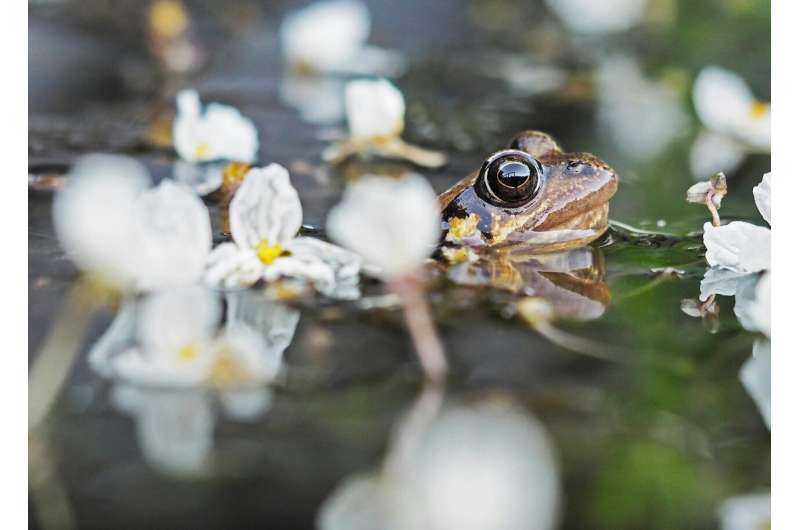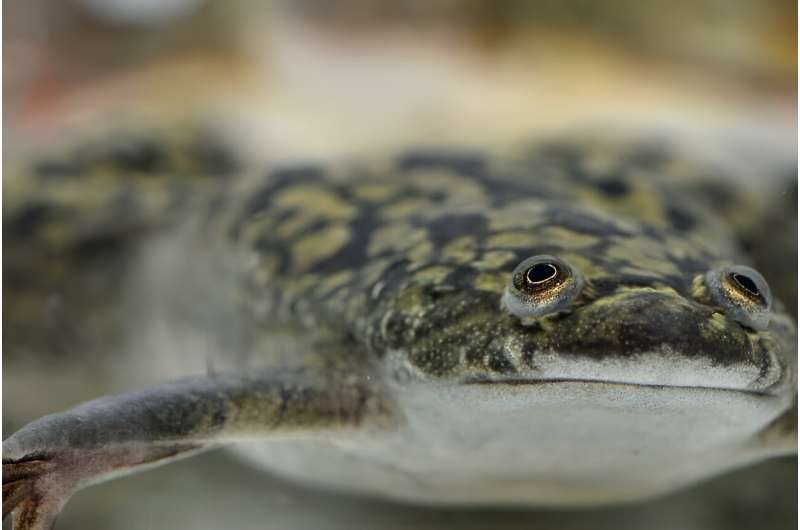This article has been reviewed according to Science X's editorial process and policies. Editors have highlighted the following attributes while ensuring the content's credibility:
fact-checked
peer-reviewed publication
trusted source
proofread
Examining the range of adulterants that disrupt the hormones of fish and amphibians

The contraceptive pill is obviously not intended for fish and frogs. However, the hormones in the pill and other pharmaceuticals that are not completely broken down in sewage treatment plants can affect aquatic organisms.
This is because the human hormone system is not so different from that of other vertebrates. In fact, the same transmitters and receptors are often involved. The World Health Organization (WHO) calls these substances or their mixtures endocrine disruptors, and there are regulations to assess and reduce the risk to humans and animals.
Researchers at IGB recommend expanding the definition and test methods for endocrine disrupters. In addition to chemicals, other factors such as certain plant substances, parasitic infections, or light pollution can disrupt the endocrine system.
Their study on this topic is published in the journal Philosophical Transactions of the Royal Society B: Biological Sciences.
Chemical communication is the basic concept for the exchange of information in an organism. In "higher" animals and in humans, three central systems have developed for this communication: the immune system, the nervous system, and the endocrine system. The hormone system controls important body processes such as growth and development, behavior, metabolism and reproduction.
Endocrine disruptors in freshwater ecosystems
According to the World Health Organization (WHO), endocrine disrupters are chemicals or mixtures of chemicals that enter the environment and interfere with the endocrine systems of animals and humans.
The most prominent examples are plasticizers, which act similarly to female sex hormones, and hormones from the contraceptive pill, which do not break down completely in wastewater treatment plants.
These endocrine disrupters accumulate in surface waters, making fish and amphibians particularly vulnerable: They may become predominantly female or become hermaphrodites, and some frogs may remain tadpoles forever.
To date, endocrine disrupters have been categorized for regulatory purposes according to the so-called EATS model. This indicates whether they have estrogenic, androgenic, thyroidal (on the hormones produced in the thyroid), or other steroidal effects.
The model, therefore, covers the part of the hormone system associated with reproduction via sex steroids, steroidogenesis and metabolism, and development (e.g., the metamorphosis of tadpoles into frogs, which is controlled by the thyroid gland). There are validated test methods for these, known as OECD test guidelines.
However, the research team points out in the current literature review that not all hormonal systems are incorporated in the EATS model and that there are other hormonally active factors that are not regulated. "It is important to consider these previously unrecognized pathways and endocrine disruptors in risk assessment," said IGB researcher Prof. Werner Kloas, lead author of the study.
Substances in the mini-pill not covered by the EATS model
One hormone system that is not covered by the EATS model are the progestogens, also known as luteal or pregnancy hormones, because they help to initiate and maintain pregnancy. A well-known endocrine disruptor of this hormone system is levonorgestrel, a common contraceptive in the "mini-pill."
Particularly drastic effects on reproduction have been observed in fish at very low concentrations. In frogs, it was not so much sexual development that was affected but the thyroid system and mating calls. Other examples of hormone systems not previously considered in the EATS model include insulin receptor signaling, gastrointestinal tract hormones, and cardiovascular hormones, i.e., hormones that control blood circulation.
Phytochemicals from soybean as potential endocrine disruptors in cattle and fish
In addition to manmade chemicals, natural substances can also be hormonally active. Phytoestrogens, for example, act like the female sex hormone. They only reach high concentrations when they are enriched, as in cosmetics or food supplements. Limit values must, therefore, be observed for cosmetics artificially enriched with phytoestrogens. The use of soybean-based feed could also pose a risk to the reproduction of ruminants or fish in aquaculture.

Rising temperatures may also affect the endocrine system
In fish, temperature-dependent sex differentiation is rare and limited to a few species. In amphibians, sex differentiation is not temperature-dependent, but primary genetic sex signals can be switched off depending on temperature. This occasionally occurs naturally and may occasionally lead to sex reversal.
"Rising temperatures in the course of climate change and other endocrine disruptors should be further considered in context to hormone responses and investigated scientifically, especially since the knowledge on genetic sex determination and the consequences of endocrine disruption is very scarce in wild amphibian species," said IGB researcher Dr. Matthias Stöck, another author of the study.
Fish tapeworm blocks development of reproductive organs in host fish
Parasites have developed strategies to alter the behavior or metabolism of their hosts to their advantage. Among fish parasites, the tapeworm Ligula intestinalis is known to affect the endocrine system of its host fish and interfere with reproductive functions. L. intestinalis can even completely block the development of the reproductive organs of its host fish, the common chub and roach, by reducing the expression of gonadotropin genes, and thus, the amount of sex hormones in both male and female host fish.
Light pollution affects the sleep hormone melatonin
The fact that light regimes affect reproductive hormones, particularly in seasonally spawning fish, is used in aquaculture to target or suppress reproduction. Therefore, it stands to reason that light pollution has the potential to act as an endocrine disruptor.
"Light pollution is not an 'external substance' to which we are exposed, but a physical force caused by electromagnetic radiation. The WHO definition of endocrine disruptors, therefore, does not include light pollution as an environmental factor, although there is already evidence that light pollution poses a risk of disrupting the endocrine systems of fish and amphibians," said Kloas.
The team studied the effects of light pollution on hormones of the stress, thyroid, and reproductive systems, as well as on the production of the sleep hormone melatonin in fish such as roach and perch. Under laboratory conditions, melatonin secretion was already significantly impaired at the lowest nocturnal light exposure of 0.01 lux (for comparison, illumination during a full moon is about 0.2 lux), while even higher exposures did not trigger a stress response via cortisol.
"Natural endocrine disruptors may play a role, but they have been shaping organisms for a long time through co-evolution without leading to a loss of biodiversity. Future research and regulatory efforts should, therefore, focus on minimizing anthropogenic endocrine disruptors," said co-author Dr. Andrea Ziková-Kloas, guest scientist at IGB and head of the Ecotoxicology Laboratory at the Federal Environment Agency (UBA). "These can certainly also be non-chemical influences."
Risk assessment challenge: Different endocrine systems do crosstalk
One of the challenges in risk assessment of endocrine disrupters is that they cause harm indirectly through disruption of the endocrine system rather than through direct toxic effects.
This means that there is no immediate damage or harm. It is also important to remember that a single endocrine disruptor can potentially disrupt several endocrine systems in parallel. For example, reproductive hormone systems are closely linked to thyroid hormones, which are important for growth and development. They also interact closely with the immune and nervous systems.
Alternatives to animal models are improving
"In order to assess these interactions, specific test approaches are needed," said Ziková-Kloas. Animal experiments are still often used because the complexity of the processes can only be understood in the whole organism.
However, the amazing progress made in establishing organoid cultures that reconstruct an endocrine organ such as the thyroid, or even multi-organoids-on-a-chip from mammalian stem cells, offers increasingly fascinating opportunities to combine different endocrine organ systems in one in vitro system.
"The development of such organoids-on-a-chip could improve our fundamental understanding of how different endocrine systems interact with each other," said the scientist. "However, classical endocrine systems are regulated by feedback mechanisms, including cerebral levels, which is the main challenge in such attempts to reconstruct a classical endocrine system."
More information: Werner Kloas et al, Endocrine disruption in teleosts and amphibians is mediated by anthropogenic and natural environmental factors: implications for risk assessment, Philosophical Transactions of the Royal Society B: Biological Sciences (2024). DOI: 10.1098/rstb.2022.0505
Journal information: Philosophical Transactions of the Royal Society B
Provided by Forschungsverbund Berlin e.V. (FVB)


















